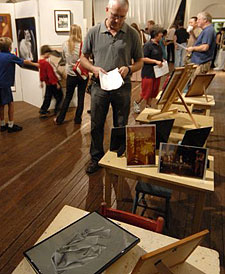Artists have been working with the church for thousands of years.
Some of their greatest and most famous works were commissioned by religious figures, and depict scenes or themes from the Bible.
But what place do artists and their work have in Sydney Anglican churches today?
How are churches using art?
 The congregation of Petersham Evening Church includes a healthy scattering of students, filmmakers, painters and art teachers.
The congregation of Petersham Evening Church includes a healthy scattering of students, filmmakers, painters and art teachers.
The church uses visual art displays and events to attract the community's attention, says Minister Malcolm Williams - also Director of The Fellowship for Evangelism in the Visual Arts (FEVA).
These include outdoor movie screenings, artwork exhibitions and large sculptural works on the roof of the church.
Posters and fliers pointing at events such as carol services link the art to the church.
Malcolm says the value of this visual approach lies in prodding people to think.
"Images, movies, cartoons can be wonderful provokers," he says.
“People in the community want to know what it’s ‘all about’.”
Malcolm hopes the artworks make church more accessible to the area’s locals.
"Things like a revolving giant jigsaw puzzle on the roof let the community that the kind of people who made this come here " and that there are exciting gospel activities happening."
Art = evangelistic opportunity
Malcolm is helping other churches think through the concept of incorporating art into evangelistic events.
"A number of ministers have mentioned to me that they feel the way into secular culture is through the arts," he says.
Ben Underwood, Assistant Minister at St Mark's Darling Point, has been brainstorming ideas for making contact with people in the local community.
"People in the Eastern Suburbs are affluent, they're professional, capable polished people, so when we do anything for public consumption, we do it carefully," he observes.
Darling Point are exploring ideas for artistic/evangelistic events, including a jazz night, a film festival, or themed art appreciation evenings.
"You can build an exhibition around a theme, particularly if the artists are on hand to unpack the thinking behind the art," he explains.
Ben says visual elements are a valuable way of introducing people to the idea of God.
"(Visual arts) are not going to lead to them understanding the gospel, but might make them more ready to hear it," he says.
"There's no end of opportunities," says Malcolm. "Our culture is a visual culture and to get involved and be in the marketplace of ideas is a huge evangelistic opportunity."
The artist’s aim
Artist Fiona Pfennigwerth says manuscript discovery " reading Scripture without chapters, headings and verse numbers " led her to paint botanical watercolours based on books of the Bible.
She says paintings can highlight the Bible's structure and themes.
In her 9-painting series on Ruth, she includes a dead leaf and bitter-tasting bush fruit to convey the themes of death and despair in the first chapter.
Art encourages and motivates people to read the text, she says.
"It can be daunting for someone starting out," she says. "My primary aim is to make the Bible not scary."
She says her paintings are not a representation of the Bible, "like going to a movie of a book you've read", but things that spark people's interest.
"It's a bit like a whodunnit " you look at the painting and ask, "Why is that there?," she says.
"It's not a commentary " it just gives clues."
Can art be a distraction " or worse?
Malcolm says visual elements in church meetings need to be used with care.
"There's huge potential to distract and for people to feel like the (church) meeting is not valid if we don't have sophisticated images or use powerpoint."
One difficulty is the problem of controlling what visual elements mean to different people, he says.
"For example, we might decide to portray a scene from the Old Testament, but small details in the way we present it may lead a person to wrongly understand the events or narrative of the passage.
“We shouldn’t underestimate the power of God’s word to correctly provoke our imaginations.”
The obvious example is portraying Jesus.
"It's very important that we don't show Jesus as a particular man… it can cloud and confuse people’s relationship with Jesus."
Christians are rightly cautious of using images in church, Malcolm says.
"One significant reason Christians have historically been suspicious of the image is the golden calf," he says, connecting the issue with Aaron’s attempt to visualise God that ended in idolatry.
While Malcolm is exploring creative ways of doing church, he says the central goals at Petersham are the Scriptures and fellowship.
"It is important that we have real and vital fellowship around Jesus as we meet him in his word.
“The fact that we have Jesus in common far surpasses any common interest in the arts."
Chat with Fiona Pfennigwerth at her exhibition of watercolour paintings on Ruth at St Andrew’s Cathedral on Saturday March 24 from 2pm to 4:30pm.
Visit the FEVA website.

















